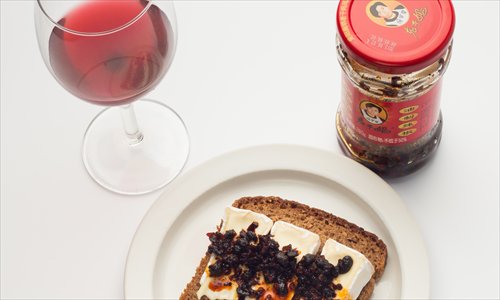How Lao Gan Ma chili sauce is winning over international palates

Simon Stahli, the Swiss founder of "The Lao Gan Ma Appreciation Society" Facebook page, is a longtime fan of the sauce. Photo: Courtesy of Simon Stahli
It was on a 2003 trip to China that the Fischers, an American couple from Raleigh, North Carolina, first discovered Lao Gan Ma chili sauce. They were browsing the condiment aisle in a local grocery store when they spotted the glass jar with its bright red label.
"I thought it looked unusual," remembers Mike Fischer. "In the US, all the faces on product labels have big smiles, but Lao Gan Ma featured a woman with a very serious face."
On a whim, they bought a bottle, and later tried it out with a plate of pot stickers. They were immediately hooked - with its crispy chili flakes, rich, oily flavor and smooth heat, Lao Gan Ma offered the perfect complement to their meal. "It offers not just spice, but also flavor and texture," says Fischer.
Best of all were the peanuts - crunchy bits of shrapnel that, Fischer, being the gentleman he is, picked out of his bowl and gave to his wife - something that, 13 years later, has now become a habit for the couple.
"She told me she can feel my affection for her [whenever I do it]," he laughs. "There are not too many peanuts in a jar, so each one is like a little prize."
Since that first taste, the couple has conceived a burning (no pun intended) love for Lao Gan Ma.
Fischer, now 49, has gotten a number of chances to return to China thanks to his job in the video game industry, and he soon got in the habit of picking up a jar or 10.
The couple even bring their adult sons a jar whenever they visit. "It is now a special kitchen ingredient for two generations of our family."
The Fischers aren't alone; in recent years, Lao Gan Ma has seen growing popularity overseas, even earning itself an online fan club: "The Lao Gan Ma Appreciation Society," a Facebook page that, as of the time of publishing, has 1,146 mostly foreign members.
Like Fischer, many overseas Lao Gan Ma fans believe there's a reason why this particular sauce caters to international palates.
Many have realized that not only does it offer its own distinct flavor and cultural associations, but a certain versatility that makes it perfect for everything from Chinese pot stickers to Mexican food; in other words, the perfect fusion of East and West.

Overseas Lao Gan Ma fans explore unique ways of pairing the Chinese sauce with Western dishes and ingredients, such as bread, wine and cheese. Photo: Courtesy of Simon Stahli
The 'grumpy lady' sauce
Lao Gan Ma (which means "old godmother" in Chinese) was founded in Guiyang, Guizhou Province in 1996 by Tao Huabi - the grouchy-looking woman on the label - who reportedly earned the nickname "godmother" thanks to her mothering nature.
Since then, the brand has grown into a household name, with a range of popular flavors that include chili in oil, spicy chili crisp and soybean chili sauce.
Fischer said the sauce has the magical power of transforming vegetables or leftovers he doesn't like into something delicious.
"[My wife] is not always happy when I prefer the 'Grumpy Auntie' taste over her cooking," he jokes. "I also add it to Mexican food, such as tacos and burritos. It adds a nice hot flavor that matches the Mexican spices very well."
In the past, the couple used to stock up whenever they traveled to China, but in recent years, that hasn't been necessary.
"It is much easier to find [in the US] now," Fischer says.
"I have also noticed that recently other companies are selling sauces with a very similar label design."
Lao Gan Ma may be available overseas, but it doesn't come cheap. On Chinese e-commerce platform yhd.com, a 280-gram jar of the soybean chili sauce costs 8.8 yuan ($1.35), while on amazon.com in the US, the same jar of sauce sells for a whopping $8.99.
Price aside, Fischer thinks Lao Gan Ma has big potential in Western markets. "I think it could be very popular in the US and has the potential to sell beyond just Asian markets," he says.
Fischer is evidence of the brand's potential for gaining customer loyalty among Westerners - he says he'd love to watch a documentary about Lao Gan Ma and even visit their factory in China one day.
Sentimental associations
It isn't just its flavor that's earned Lao Gan Ma a special place in many fans' hearts. For the creator of the Facebook page - 39-year-old Simon Stahli, an artist and photography teacher from Switzerland - the chili sauce is a memento of times past.
"It elicits an exciting time in my life - a time when I made many close friends."
He was first introduced to the sauce in 2002, when he was studying filmmaking in the UK, along with classmates from everywhere in the world. That's where he met his wife, a Chinese woman from Guiyang, where Lao Gan Ma comes from.
He remembers one particular Christmas dinner hosted by his British classmates, with "very dry turkey meat, greasy Yorkshire puddings, over-boiled brussel sprouts and potatoes."
"I had to suppress my laughter when I heard all the Chinese students discreetly mention how 'nanchi' (not tasty) it was," Stahli said. Fortunately, a jar of Lao Gan Ma came to the rescue, adding flavor to the lackluster dishes.
"Anything can be made edible with some Lao Gan Ma!" he said.
Stahli instantly fell in love. "It's a perfect combination between the oil, the chili flakes and the fermented beans. Not just the taste, but the variety of the textures is just perfect."
Since then, Stahli has been working to convert those around him to the Lao Gan Ma way, starting with the Facebook page, which he launched in 2006. In the beginning, he says, the group didn't really go anywhere.
"It had just five followers for a long time," he said. Among the early followers were a fair share of homesick Chinese students.
In recent years, though, he's had more success, in part, he thinks, because people's palates are growing more open-minded. He's introduced Lao Gan Ma to a number of friends and family members, successfully converting his sister and cousin, among others.
Another fan is 30-year-old German Christian Michael Mengeu, who loves the subtle spiciness of the sauce and the fact that "it adds flavor to everything." He said he puts in on rice, pasta and even baked potatoes.
"I love the combination of the salty, oily chili flavor it adds."
Though he now lives in Amsterdam, where he studies business management, Mengeu spent his teenage and young adult years in Beijing before leaving China in 2014. For him, the sauce is "always associated with home cooking" of the kind "your grandmother would make."
"I think that's the brand image Lao Gan Ma should stick to. It's very homey and feels like comfort food to me."
While most foreigners won't share the same nostalgic associations as Mengeu, he believes that foodies in the West are increasingly interested in experimenting with Asian foods.
"A new hip Chinese sauce could get popular, just like Sriracha," he said, referencing the Thai chili sauce that in many parts of the world has become a popular staple.
A fusion of East and West
According to Stahli, influenced by neighboring countries like France, Germany and Italy, Swiss people embrace a variety of breads and cheeses, as well as Italian imports like pasta and pizza.
"Spicy foods are traditionally not on our menu at all," he said. But he says he's noticed that Lao Gan Ma works well with Swiss food.
Anneke Garcia, 34, considers Lao Gan Ma "very special, fancy and exotic," and says it often impresses her friends when they come over to dine.
An instructional designer and mother of two children, Garcia lives in Salt Lake City, Utah, where, luckily for her, there are lots of Chinese grocery stores that sell Lao Gan Ma.
The sauce has proven a hit, not only with Garcia's friends, but with her husband, who's from Honduras. "He eats it on everything," she says.
She added that it goes especially well with Central American and Mexican food, which are staples in her household.
"The best way to incorporate Lao Gan Ma that I have found is in a dish called carne asada (a type of grilled meat usually seen in South America)," she said.
She takes thinly sliced beef and, instead of using the normal sauce of spices, peppers and vinegar, marinates it in a mixture of Lao Gan Ma and lime juice.
"[The sauce] makes it a little spicier and it gives it more umami."
Garcia added that she thinks Lao Gan Ma has big potential in the US.
"I think it would be very possible to popularize it here," she says. "Americans really love new foreign foods."
The charm of rusticism
For Stahli, Lao Gan Ma represents something "authentic and unpretentious," as evidenced partly by its packaging, which features a red-yellow-black color scheme and the grumpy-looking Tao Huabi.
"People in the West often like aspects of Chinese culture that may be unexpected to the Chinese - things that would be considered extremely tu (unfashionable, earthy) in China," he said.
He gave an example of a shop in his hometown that does well selling things like old-fashioned Chinese thermoses and enamel washbasins with floral designs, at "eye-watering" prices.
Also, when the Stahli and his wife travel to China, their friends in Switzerland always ask them to bring home some military green "liberation shoes," a kind of canvas shoe that was first worn by the People's Liberation Army and then by ordinary Chinese people dating back to the 1950s.
Stahli thinks Westerners' appreciation for Lao Gan Ma is in line with the growth of the hipster movement.
"Consumers are becoming more sophisticated, and they are looking for the quirky and unexpected," he said.
"People are focusing again on the simple joys of life, and are losing interest in mass market consumerism."
Newspaper headline: Enter the ‘godmother’